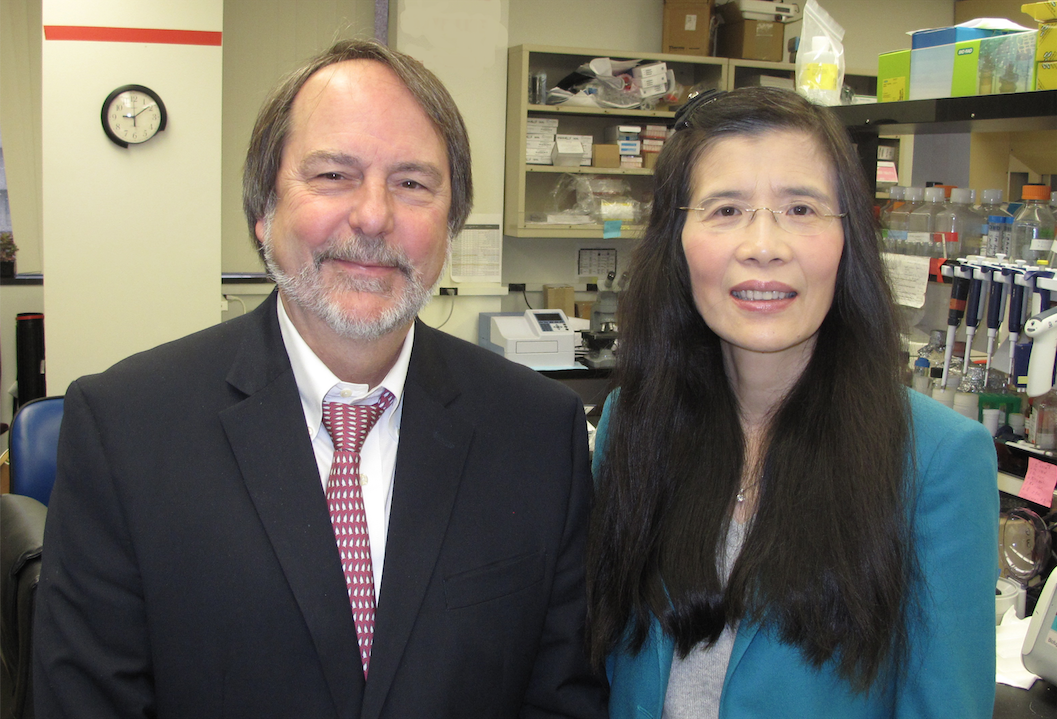Genetic disorders are notoriously difficult to treat and it is extremely rare for medicine to develop an actual fix at the genetic level. But Department of Dermatology co-investigators Mei Chen, PhD, and David T. Woodley, MD, are preparing to begin human trials with protein replacement therapy for sufferers of recessive dystrophic epidermolysis bullosa (RDEB)—an inherited disorder that leads to devastating, erosive skin wounds and cancers.

The RDEB gene mutation interferes with the body's production of type VII skin collagen, which forms anchoring fibrils that knit together the epidermal and dermal layers of skin. Lacking this fundamental element of skin structure, RDEB children and adults navigate a worsening path of skin fragility, scarring, and the development of erosive, hard-to-heal wounds.
"At first children with RDEB will develop water blisters, and the majority of patients eventually develop wounds all over their body, with serious complications as they age," said Chen. The damage is not restricted to the skin surface, she explained, but affects internal organs as well, such as the esophagus. The majority of patients develop cancers by adulthood.
Chronic itching is a common symptom, but scratching the itches can damage the skin. In fact, children and adults with the condition—especially active people—must learn to minimize any kind of trauma or skin injury, and to bandage affected areas regularly.
"Although many RDEB patients live into adulthood, their lives are severely challenged," said Woodley. "And families may spend hundreds of thousands of dollars on bandages and health care." Fortunately, the condition is rare, with an estimated 2 million to 3 million patients worldwide.
Chen and Woodley have been studying treatment approaches for RDEB for almost 25 years. About seven years ago, the SC CTSI provided pilot funding for a feasibility study; other assistance came from SC CTSI cores in the areas of research design and regulatory knowledge and support for budgeting and study design to help the pair get their research off the ground. In 2011, they helped to form a company to develop and commercialize a protein replacement therapy, obtaining $26 million in venture capital funding.
Small grants lead to larger grants.
"Going through that process with the SC CTSI allowed us to submit a larger grant application to the NIH for considerably more money, which we received," said Woodley
Initially, Chen and Woodley developed and tested therapies, in preclinical animal models, to replace the missing collagen protein, both through topical applications and by local intradermal injections of type VII collagen at the site of skin wounds. Results were encouraging, with test areas showing long-term healing and wound-closure. In the search for a treatment that would improve symptoms broadly throughout the body, they also showed the feasibility of a systemic approach by delivering type VII collagen intravenously, which has the potential to treat multiple wounded areas of the skin and mucous membranes simultaneously.
Reading through the nonsense mutations.
In more recent studies, Chen and Woodley wanted to investigate a well-known antibiotic called gentamicin. Unrelated to its anti-bacterial function, the drug has an unusual property: it can "read through" a nonsense mutation where the translation of the gene is terminated early, leaving the rest of the gene untranslated and leading to a smaller protein that is non-functional. Gentamicin allows the translation to read through the mutation and create a full-length functional type VII collagen that in RDEB patients is absent or incomplete.
The gentamicin therapy works in some 20 to 25 percent of RDEB patients—those who have a particular type of nonsense mutation. It is not completely understood how the drug enables the full gene translation, said Woodley
In a paper published last year, in the Journal of Clinical Investigation, Chen and Woodley described their tests of both topical applications and local injections of gentamicin and showed that gentamicin could induce the production of normal type VII collagen—as well as the development of the anchoring fibrils that hold the epidermal and dermal layers of skin together—in a pilot clinical trial supported in part by grants from the Epidermolysis Bullosa Research Partnership and the Epidermolysis Bullosa Medical Research Foundation. Topical gentamicin also corrected dermal-epidermal separation, improved wound closure, and reduced new blister formation.
Chen and Woodley are now conducting clinical trials supported by NIH grant to evaluate the effect of the gentamicin given intravenously to RDEB patients. If effective, it would provide a specific treatment for that portion of the patient population who have nonsense mutations.
